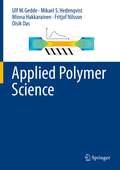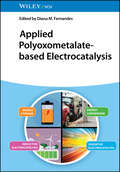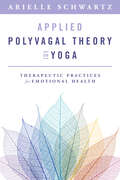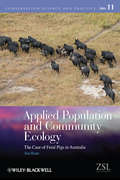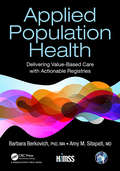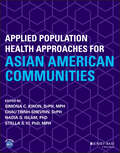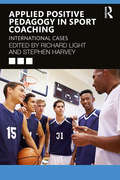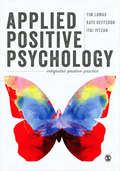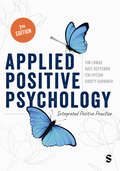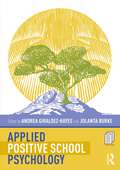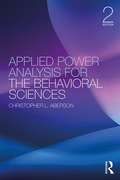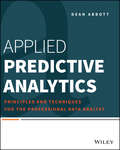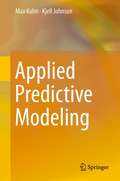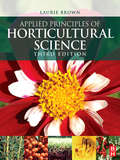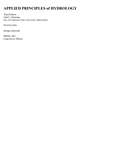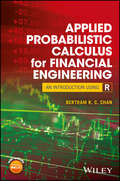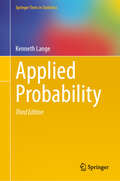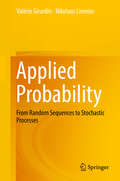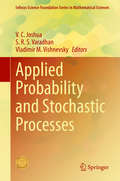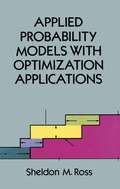- Table View
- List View
Applied Polymer Rheology
by Marianna KontopoulouExplore polymer rheology from an industrial standpoint Presenting state-of-the-art polymer rheology as observed by well-recognized authors, Applied Polymer Rheology: Polymeric Fluids with Industrial Applications is designed to help readers understand the relationship between molecular structure and the flow behavior of polymers. In particular, it focuses on polymeric systems that elicit special attention from industry. Providing a comprehensive overview of the rheological characteristics of polymeric fluids, the book bridges the gap between theory and practice/application, enabling readers to see the connection between molecular structure and the behavior of the polymers studied. Beginning with a discussion of the properties, processability, and processing aids of specific polymers, later chapters examine filled polymers and composites, and the theoretical framework upon which their analysis is based. Various systems containing microstructure are presented subsequently, with the final chapter introducing paste extrusion of polytetrafluoroethylene paste. An invaluable reference guide that covers the literature and vast array of technical approaches to polymer rheology, Applied Polymer Rheology's coverage of polymeric fluids of interest to industry make it an essential resource for plastics, polymer, and chemical engineers, materials scientists, polymer chemists, and polymer physicists to use when interpreting findings and planning experiments.
Applied Polymer Science
by Ulf W. Gedde Mikael S. Hedenqvist Minna Hakkarainen Fritjof Nilsson Oisik DasThis companion volume to “Fundamental Polymer Science” (Gedde and Hedenqvist, 2019) offers detailed insights from leading practitioners into experimental methods, simulation and modelling, mechanical and transport properties, processing, and sustainability issues. Separate chapters are devoted to thermal analysis, microscopy, spectroscopy, scattering methods, and chromatography. Special problems and pitfalls related to the study of polymers are addressed. Careful editing for consistency and cross-referencing among the chapters, high-quality graphics, worked-out examples, and numerous references to the specialist literature make “Applied Polymer Science” an essential reference for advanced students and practicing chemists, physicists, and engineers who want to solve problems with the use of polymeric materials.
Applied Polyoxometalate-Based Electrocatalysis
by Diana M. FernandesWell-researched reference on stable alternative electrocatalysts and electrode materials with the potential to transform chemistry and processes in sensor- and energy-related technologies Applied Polyoxometalate-based Electrocatalysis delivers an overview of the variety of efficient applications of free POM and POM-based (nano)composites as exciting materials in the field of electrocatalysis. With a variety of sizes, shapes, composition, and physical and chemical properties, these composites have important properties, such as the ability to undergo reversible multivalence reductions/oxidations, leading to the formation of mixed-valence species, which brings about favorable electrocatalytic properties with regard to several electrochemical processes. Edited by a highly qualified independent researcher internationally recognized for her contributions to materials for electrochemical energy-related reactions, Applied Polyoxometalate-based Electrocatalysis includes information on: General methodologies used in the preparation of free POMs and POM-based nanocomposites and different strategies employed in electrode modification Role of POM-modified electrodes in oxidative and reductive electrocatalysis, including the detection/sensing of several (bio)molecules of interest and carbon dioxide electroreduction Application of POM-based (nano)composites, including the oxygen reduction reaction relevant to fuel cells, the oxygen and hydrogen evolution reactions, and batteries and supercapacitors Applied Polyoxometalate-based Electrocatalysis is an essential reference on the subject for chemists, material scientists, chemical engineers, and institutions involved in work related to free POM and POM-based (nano)composites.
Applied Polyvagal Theory in Yoga: Therapeutic Practices for Emotional Health
by Arielle SchwartzTreat trauma holistically with the combined applications of yoga and polyvagal theory. This book focuses on the intersection of polyvagal theory, yoga, and psychotherapy by weaving together the wisdom tradition of yoga with neuroscience, attachment theory, somatic psychology, and traumatology. The application of polyvagal theory allows practitioners to compassionately support growth by enhancing the health of the autonomic nervous system, while therapeutic yoga allows one to attend to the interrelationships between mind, emotions, physiology, and behavior. Applied Polyvagal Theory in Yoga provides conscious breathing, vagal toning, mindful movement, and meditation practices that aid in rewiring the nervous system. Readers will discover how to help both clients and themselves cultivate a felt sense of ease during times of safety; enhance their capacity to handle challenges with equanimity; and reclaim their ability to recover from stress swiftly and efficiently. Applied Polyvagal Theory in Yoga offers practitioners a new and effective way to support clients who are stuck in a trauma response mode.
Applied Population and Community Ecology: The Case of Feral Pigs in Australia (Conservation Science and Practice)
by Jim HonePart of the Zoological Society of London's Conservation Science and Practice Series, Applied Population and Community Ecology evaluates theory in population and community ecology using a case study of feral pigs, birds and plants in the high country of south-eastern Australia. In sequence, the book reviews the relevant theory and uses long-term research over a quarter of a century on the population ecology of feral pigs and then community ecology of birds and plants, to evaluate the theory. The book brings together into one volume, research results of many observational, experimental and modelling studies and directly compares them with those from related studies around the world. The implications of the results for future wildlife management are also discussed. Intended readers are ecologists, graduate students in ecology and wildlife management and conservation and pest managers.
Applied Population Health: Delivering Value-Based Care with Actionable Registries (HIMSS Book Series)
by Barbara Berkovich, PhD, MA Amy Sitapati, MDElectronic Health Record (EHR) systems today provide increasing levels of clinical decision support and are the fulcrum for change for value-based healthcare delivery. Billions of dollars of government and insurer payments are dependent on evidence-based workflow design and quality report. In this context, quality measurement is no longer a retrospective exercise, but an essential prospective process embedded in clinical operations. Population health tools in the EHR enhance the efficiency and effectiveness of interventions thus improving the quality of care at lower cost. Population health methods are effective in ensuring that the right patient receives the right care at the right time. This book provides a clear framework for design, implementation, and monitoring of innovative population health tools to accelerate measurable improvements in care delivery. Key benefits for readers include conceptual framework, team approach, and technical insights that result in improved patient care, improved performance on quality measures and increased revenue from quality performance incentives and risk-based contracts. This is also a practice guide to the healthcare professionals many roles who are eager to build or improve population health programs with the goal of delivering high quality value-based care.
Applied Population Health Approaches for Asian American Communities (Public Health/Vulnerable Populations)
by Simona C. Kwon Chau Trinh-Shevrin Nadia S. Islam Stella S. YiAn insightful text exploring health disparities in Asian American populations In the newly revised Second Edition of Applied Population Health Approaches for Asian American Communities, a team of distinguished public health experts delivers a groundbreaking resource providing an in-depth examination of the soical, political, economic, and cultural forces shaping Asian American health today. Integrating up-to-date applied public health research for assessing health interventions and programs relevant to Asian American communities and other groups that have been historically marginalized, this book highlights the different frameworks, research designs, and other methodological considerations for reaching Asian American and other ethnic communities. In the latest edition of the book, readers will find contextual explorations of the Asian American population in the United States, as well as discussions of the measurement of health and risk across the lifespan in Asian American groups. It also includes: New and updated case studies showcasing the application of different frameworks and research designs Methodological considerations for reaching Asian American and other vulnerable and underserved communities Examples of successful implementations of community engagement and community-based participatory research. A valuable resource for all levels of health professionals, practitioners, and community advocates, Applied Population Health Approaches for Asian American Communities remains the leading reference for anyone conducting or studying health disparities in Asian American communities or other groups that have been marginalized.
Applied Positive Pedagogy in Sport Coaching: International Cases
by Richard LightPositive Pedagogy is an athlete-centred, inquiry-based approach that transforms the way we understand learning and coaching in sport and can be successfully employed across a range of different sports and levels of performance. Applied Positive Pedagogy in Sports Coaching: International Cases reflects the uptake of Positive Pedagogy by coaches across different countries and sport settings through its complete focus on their experiences of using it and adapting it to their needs and contexts. Comprising 17 detailed chapters that examine both Team Sports (Part 1) and Individual Sports (Part 2), this book seeks to provide insight into the opportunities and challenges involved in the application of Positive Pedagogy for sport coaching (PPed). Critically, it also identifies any problems the coaches encountered, how they addressed them and what they learned from these experiences. Acting as a complementary text to the successful Positive Pedagogy for Sport Coaching, 2nd edition, Applied Positive Pedagogy in Sports Coaching: International Cases is an exciting, applied text that will be vital reading for all practising sports coaches or physical education teachers looking to improve or even transform their professional practice, as well as sports coaching students and researchers.
Applied Positive Psychology: Improving Everyday Life, Health, Schools, Work, and Society (Applied Psychology Series)
by Stewart I. Donaldson Mihaly Csikszentmihalyi Jeanne NakamuraPositive Psychology has experienced extraordinary growth over the past decade. Emerging research in this area is suggesting new strategies for improving everyday life, healthcare, education systems, organizations and work life, and societies across the globe. This book will be of interest to all applied psychologists, applied researchers, social and organizational psychologists, and anyone interested in applying the science of positive psychology to improvement of the human condition.
Applied Positive Psychology: Integrated Positive Practice
by Dr Tim Lomas Kate Hefferon Itai IvtzanInstructors - Electronic inspection copies are available or contact your local sales representative for an inspection copy of the print version. “If you think you know what positive psychology is, think again! This book offers a new integrative vision for making life better that takes in the body and the brain, culture and society, childhood and development... A must read for students.” - Stephen Joseph, University of Nottingham "Captures the best of the positive psychology initiative, and most importantly, translates it to practice. The authors bring remarkable depth and breadth to the subject matter and do so in a way that is fresh, engaging, relevant, and unusually thoughtful." - Carol Ryff, University of Wisconsin-Madison "If you want to understand what positive psychology really is, learn how it works in practice and discover its huge potential to transform our lives and our world then look no further than this superb book. I really can't recommend it highly enough." - Mark Williamson, Director of Action for Happiness This exciting new textbook, written by leading academics in the UK, offers the very first authored title on applied positive psychology for university courses. Consisting of the latest cutting-edge theory and research in the subject and structured around a pioneering multidimensional model of wellbeing, this book will provide you with the knowledge and tools to apply positive psychology in many areas of life. These include interventions aimed at developing mental and physical functioning, to recommendations for enhancing relationships and reshaping organisational structures. The book shows how these practices can be successfully deployed in diverse real-world settings, from the classroom to the workplace. Key features include: Learning objectives set out at the start of each chapter Practice essay questions throughout and quizzes to test your knowledge at the end of each chapter Useful measurement tools and recommendations for research Summary boxes and suggested further reading and resources Case studies and ‘Reflection’ boxes that invite you to explore topics in greater depth and relate findings to your everyday life. This book will be essential reading for all students with an interest in or studying a course in applied positive psychology, and is strongly recommended to students taking a wider course in positive psychology and the psychology of happiness and wellbeing.
Applied Positive Psychology: Integrated Positive Practice
by Dr Tim Lomas Itai Ivtzan Kate Hefferon"If you think you know what positive psychology is, think again! This book offers a new integrative vision for making life better that takes in the body and the brain, culture and society, childhood and development... A must read for students." - Stephen Joseph, University of Nottingham "Captures the best of the positive psychology initiative, and most importantly, translates it to practice. The authors bring remarkable depth and breadth to the subject matter and do so in a way that is fresh, engaging, relevant, and unusually thoughtful." - Carol Ryff, University of Wisconsin-Madison "If you want to understand what positive psychology really is, learn how it works in practice and discover its huge potential to transform our lives and our world then look no further than this superb book. I really can't recommend it highly enough." - Mark Williamson, Director of Action for Happiness "Does a brilliant job of showing readers how to apply the insights that research has uncovered. It will surely become one of the go-to text books for all students of positive psychology." - Nic Marks, creator of the Happy Planet Index, Five Ways to Wellbeing and Founder of Happiness Works This exciting new textbook, written by leading academics in the UK, offers the very first authored title on applied positive psychology for university courses. Consisting of the latest cutting-edge theory and research in the subject and structured around a pioneering multidimensional model of wellbeing, this book will provide you with the knowledge and tools to apply positive psychology in many areas of life. These include interventions aimed at developing mental and physical functioning, to recommendations for enhancing relationships and reshaping organisational structures. The book shows how these practices can be successfully deployed in diverse real-world settings, from the classroom to the workplace. Key features include: Learning objectives set out at the start of each chapter Practice essay questions throughout and quizzes to test your knowledge at the end of each chapter Useful measurement tools and recommendations for research Summary boxes and suggested further reading and resources Case studies and 'Reflection' boxes that invite you to explore topics in greater depth and relate findings to your everyday life. This book will be essential reading for all students with an interest in or studying a course in applied positive psychology, and is strongly recommended to students taking a wider course in positive psychology and the psychology of happiness and wellbeing.
Applied Positive Psychology: Integrated Positive Practice
by Tim Lomas Kate Hefferon Itai Ivtzan Kirsty GardinerUpdated with the latest theory and research and structured around a pioneering multidimensional model of wellbeing, this book equips you with the knowledge and tools to apply positive psychology to many areas of life. This includes interventions aimed at developing mental and physical functioning, as well as recommendations for enhancing relationships and reshaping organisational structures. A wealth of case studies show you how these practices can be successfully deployed in diverse real-world contexts, such as society, religion, the classroom and the workplace. Key features include: Learning objectives Practice essay questions and quizzes Useful psychometric tools you can adapt for your own research Summary boxes Case study and reflection boxes Suggested further reading Keyword definitions and glossary list of acronyms This book is essential reading for students of Applied Positive Psychology or the Psychology of Happiness and Wellbeing. Tim Lomas is a Psychology Research Scientist in the Department of Epidemiology at the Harvard T.H. Chan School of Public Health, and part of the Human Flourishing Program at Harvard University. Kate Hefferon has studied, lectured and worked in the areas of wellbeing and trauma research for 20 years. Itai Ivtzan is the Director of the School of Positive Transformation. Kirsty Gardiner is a Chartered Social Psychologist and a Research Director of a DEI consultancy.
Applied Positive Psychology: Integrated Positive Practice
by Tim Lomas Kate Hefferon Itai Ivtzan Kirsty GardinerUpdated with the latest theory and research and structured around a pioneering multidimensional model of wellbeing, this book equips you with the knowledge and tools to apply positive psychology to many areas of life. This includes interventions aimed at developing mental and physical functioning, as well as recommendations for enhancing relationships and reshaping organisational structures. A wealth of case studies show you how these practices can be successfully deployed in diverse real-world contexts, such as society, religion, the classroom and the workplace. Key features include: Learning objectives Practice essay questions and quizzes Useful psychometric tools you can adapt for your own research Summary boxes Case study and reflection boxes Suggested further reading Keyword definitions and glossary list of acronyms This book is essential reading for students of Applied Positive Psychology or the Psychology of Happiness and Wellbeing. Tim Lomas is a Psychology Research Scientist in the Department of Epidemiology at the Harvard T.H. Chan School of Public Health, and part of the Human Flourishing Program at Harvard University. Kate Hefferon has studied, lectured and worked in the areas of wellbeing and trauma research for 20 years. Itai Ivtzan is the Director of the School of Positive Transformation. Kirsty Gardiner is a Chartered Social Psychologist and a Research Director of a DEI consultancy.
Applied Positive School Psychology
by Andrea Giraldez-HayesApplied Positive School Psychology is an essential guide to help teachers regain their own and assist the school community in rebuilding their health post-pandemic. While research in positive psychology is thriving, teachers and educational practitioners find it challenging to apply it in their daily practice. This practical book fills the gap between theory and practice and provides practitioners with an evidence-based toolkit on using the positive psychology in their school communities. With contributions from experts in their field, this important resource explores student wellbeing, teacher wellbeing, inclusion, developing positive relationships, creativity, and therapeutic art. Written with the practitioner in mind, Applied Positive School Psychology is a must read for the teaching community and those interested in positive education. It will also be of interest to academics specialising in wellbeing or education, educational psychologists, and education policy makers.
Applied Power Analysis for the Behavioral Sciences: 2nd Edition
by Christopher L. AbersonApplied Power Analysis for the Behavioral Sciences is a practical "how-to" guide to conducting statistical power analyses for psychology and related fields. The book provides a guide to conducting analyses that is appropriate for researchers and students, including those with limited quantitative backgrounds. With practical use in mind, the text provides detailed coverage of topics such as how to estimate expected effect sizes and power analyses for complex designs. The topical coverage of the text, an applied approach, in-depth coverage of popular statistical procedures, and a focus on conducting analyses using R make the text a unique contribution to the power literature. To facilitate application and usability, the text includes ready-to-use R code developed for the text. An accompanying R package called pwr2ppl (available at https://github.com/chrisaberson/pwr2ppl) provides tools for conducting power analyses across each topic covered in the text.
Applied Predictive Analytics
by Dean AbbottLearn the art and science of predictive analytics -- techniques that get resultsPredictive analytics is what translates big data into meaningful, usable business information. Written by a leading expert in the field, this guide examines the science of the underlying algorithms as well as the principles and best practices that govern the art of predictive analytics. It clearly explains the theory behind predictive analytics, teaches the methods, principles, and techniques for conducting predictive analytics projects, and offers tips and tricks that are essential for successful predictive modeling. Hands-on examples and case studies are included.The ability to successfully apply predictive analytics enables businesses to effectively interpret big data; essential for competition todayThis guide teaches not only the principles of predictive analytics, but also how to apply them to achieve real, pragmatic solutionsExplains methods, principles, and techniques for conducting predictive analytics projects from start to finishIllustrates each technique with hands-on examples and includes as series of in-depth case studies that apply predictive analytics to common business scenariosA companion website provides all the data sets used to generate the examples as well as a free trial version of softwareApplied Predictive Analytics arms data and business analysts and business managers with the tools they need to interpret and capitalize on big data.
Applied Predictive Modeling
by Max Kuhn Kjell JohnsonThis text is intended for a broad audience as both an introduction to predictive models as well as a guide to applying them. Non-mathematical readers will appreciate the intuitive explanations of the techniques while an emphasis on problem-solving with real data across a wide variety of applications will aid practitioners who wish to extend their expertise. Readers should have knowledge of basic statistical ideas, such as correlation and linear regression analysis. While the text is biased against complex equations, a mathematical background is needed for advanced topics. Dr. Kuhn is a Director of Non-Clinical Statistics at Pfizer Global R&D in Groton Connecticut. He has been applying predictive models in the pharmaceutical and diagnostic industries for over 15 years and is the author of a number of R packages. Dr. Johnson has more than a decade of statistical consulting and predictive modeling experience in pharmaceutical research and development. He is a co-founder of Arbor Analytics, a firm specializing in predictive modeling and is a former Director of Statistics at Pfizer Global R&D. His scholarly work centers on the application and development of statistical methodology and learning algorithms.
Applied Principles of Horticultural Science
by Laurie BrownApplied Principles of Horticultural Science is that critical thing for all students of horticulture - a book that teaches the theory of horticultural science through the practice of horticulture itelf.The book is divided into three sections - Plant science, Soil science, Pest and disease. Each section contains a number of chapters relating to a major principle of applied horticulture. Each chapter starts with a key point summary and introduces the underpinning knowledge which is then reinforced by exercises. The book contains over 70 practical exercises, presented in a way that makes students think for themselves. Answers to the exercises are given at the end of chapters. Clear step-by-step instructions make practical work accessible to students of all abilities.This new third edition provides an even wider sweep of case studies to make this book an essential practical workbook for horticulture students and gardners alike. Updated material fits with the latest RHS, City and Guilds and Edexcel syllabus. It is particularly suitable for the RHS Certificate, Advanced Certificate and Edexcel Diplomas as well as for those undertaking NPTC National, Advanced National courses and Horticulture NVQs at levels 2 and 3, together with the new Diploma in Environmental and Land-based studies.Laurie Brown is a horticultural scientist and educator. He is Director of Academex, a consultancy company aspiring to excellence in teaching and learning. Laurie previously worked with the Standards Unit on the design of exemplary teaching resources in the land-based sector.
Applied Principles Of Hydrology
by John C. ManningLess than 1% of the Earth's water is available for human use, the average family uses 400 gallons of water daily, and expected population growth means an increase in water use. The study of hydrology how water behaves as it moves through the water cycle is vital to reducing strains on our water supply and infrastructure.
Applied Probabilistic Calculus for Financial Engineering: An Introduction Using R
by Bertram K. ChanIllustrates how R may be used successfully to solve problems in quantitative finance Applied Probabilistic Calculus for Financial Engineering: An Introduction Using R provides R recipes for asset allocation and portfolio optimization problems. It begins by introducing all the necessary probabilistic and statistical foundations, before moving on to topics related to asset allocation and portfolio optimization with R codes illustrated for various examples. This clear and concise book covers financial engineering, using R in data analysis, and univariate, bivariate, and multivariate data analysis. It examines probabilistic calculus for modeling financial engineering—walking the reader through building an effective financial model from the Geometric Brownian Motion (GBM) Model via probabilistic calculus, while also covering Ito Calculus. Classical mathematical models in financial engineering and modern portfolio theory are discussed—along with the Two Mutual Fund Theorem and The Sharpe Ratio. The book also looks at R as a calculator and using R in data analysis in financial engineering. Additionally, it covers asset allocation using R, financial risk modeling and portfolio optimization using R, global and local optimal values, locating functional maxima and minima, and portfolio optimization by performance analytics in CRAN. • Covers optimization methodologies in probabilistic calculus for financial engineering • Answers the question: What does a "Random Walk" Financial Theory look like? • Covers the GBM Model and the Random Walk Model • Examines modern theories of portfolio optimization, including The Markowitz Model of Modern Portfolio Theory (MPT), The Black-Litterman Model, and The Black-Scholes Option Pricing Model Applied Probabilistic Calculus for Financial Engineering: An Introduction Using R is an ideal reference for professionals and students in economics, econometrics, and finance, as well as for financial investment quants and financial engineers. BERTRAM K. C. CHAN, PhD, is Consulting Biostatistician at the Loma Linda University Health, School of Medicine, Loma Linda, CA. Dr. Chan is also Software Development and Forum Lecturer at the School of Public Health, LLUH Department of Biostatistics and Epidemiology.
Applied Probability (Springer Texts in Statistics)
by Kenneth LangeApplied Probability presents a unique blend of theory and applications, with special emphasis on mathematical modeling, computational techniques, and examples from the biological sciences. Chapter 1 reviews elementary probability and provides a brief survey of relevant results from measure theory. Chapter 2 is an extended essay on calculating expectations. Chapter 3 deals with probabilistic applications of convexity, inequalities, and optimization theory. Chapters 4 and 5 touch on combinatorics and combinatorial optimization. Chapters 6 through 11 present core material on stochastic processes. If supplemented with appropriate sections from Chapters 1 and 2, there is sufficient material for a traditional semester-long course in stochastic processes covering the basics of Poisson processes, Markov chains, branching processes, martingales, and diffusion processes. This third edition includes new topics and many worked exercises. The new chapter on entropy stresses Shannon entropy and its mathematical applications. New sections in existing chapters explain the Chinese restaurant problem, the infinite alleles model, saddlepoint approximations, and recurrence relations. The extensive list of new problems pursues topics such as random graph theory omitted in the previous editions. Computational probability receives even greater emphasis than earlier. Some of the solved problems are coding exercises, and Julia code is provided. Mathematical scientists from a variety of backgrounds will find Applied Probability appealing as a reference. This updated edition can serve as a textbook for graduate students in applied mathematics, biostatistics, computational biology, computer science, physics, and statistics. Readers should have a working knowledge of multivariate calculus, linear algebra, ordinary differential equations, and elementary probability theory.
Applied Probability: From Random Sequences To Stochastic Processes
by Nikolaos Limnios Valérie GirardinThis textbook addresses postgraduate students in applied mathematics, probability, and statistics, as well as computer scientists, biologists, physicists and economists, who are seeking a rigorous introduction to applied stochastic processes. Pursuing a pedagogic approach, the content follows a path of increasing complexity, from the simplest random sequences to the advanced stochastic processes. Illustrations are provided from many applied fields, together with connections to ergodic theory, information theory, reliability and insurance. The main content is also complemented by a wealth of examples and exercises with solutions.
Applied Probability and Stochastic Processes
by Frank BeicheltApplied Probability and Stochastic Processes, Second Edition presents a self-contained introduction to elementary probability theory and stochastic processes with a special emphasis on their applications in science, engineering, finance, computer science, and operations research. It covers the theoretical foundations for modeling time-dependent random phenomena in these areas and illustrates applications through the analysis of numerous practical examples. The author draws on his 50 years of experience in the field to give your students a better understanding of probability theory and stochastic processes and enable them to use stochastic modeling in their work. New to the Second Edition Completely rewritten part on probability theory—now more than double in size New sections on time series analysis, random walks, branching processes, and spectral analysis of stationary stochastic processes Comprehensive numerical discussions of examples, which replace the more theoretically challenging sections Additional examples, exercises, and figures Presenting the material in a student-friendly, application-oriented manner, this non-measure theoretic text only assumes a mathematical maturity that applied science students acquire during their undergraduate studies in mathematics. Many exercises allow students to assess their understanding of the topics. In addition, the book occasionally describes connections between probabilistic concepts and corresponding statistical approaches to facilitate comprehension. Some important proofs and challenging examples and exercises are also included for more theoretically interested readers.
Applied Probability and Stochastic Processes (Infosys Science Foundation Series)
by V. C. Joshua S. R. S. Varadhan Vladimir M. VishnevskyThis book gathers selected papers presented at the International Conference on Advances in Applied Probability and Stochastic Processes, held at CMS College, Kerala, India, on 7–10 January 2019. It showcases high-quality research conducted in the field of applied probability and stochastic processes by focusing on techniques for the modelling and analysis of systems evolving with time. Further, it discusses the applications of stochastic modelling in queuing theory, reliability, inventory, financial mathematics, operations research, and more. This book is intended for a broad audience, ranging from researchers interested in applied probability, stochastic modelling with reference to queuing theory, inventory, and reliability, to those working in industries such as communication and computer networks, distributed information systems, next-generation communication systems, intelligent transportation networks, and financial markets.
Applied Probability Models with Optimization Applications
by Sheldon M. Ross"A clarity of style and a conciseness of treatment which students will find most welcome. The material is valuable and well organized ... an excellent introduction to applied probability." -- Journal of the American Statistical Association. This book offers a concise introduction to some of the stochastic processes that frequently arise in applied probability. Emphasis is on optimization models and methods, particularly in the area of decision processes. After reviewing some basic notions of probability theory and stochastic processes, the author presents a useful treatment of the Poisson process, including compound and nonhomogeneous Poisson processes. Subsequent chapters deal with such topics as renewal theory and Markov chains; semi-Markov, Markov renewal, and regenerative processes; inventory theory; and Brownian motion and continuous time optimization models.Each chapter is followed by a section of useful problems that illustrate and complement the text. There is also a short list of relevant references at the end of every chapter. Students will find this a largely self-contained text that requires little previous knowledge of the subject. It is especially suited for a one-year course in applied probability at the advanced undergraduate or beginning postgraduate level. 1970 edition.

